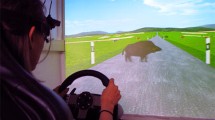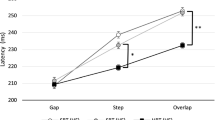Summary
Quantitative studies of latencies and trajectories of eye-head movements during visual search and fixation in patients with occipital hemianopia show that (1) the latency of head movement is bilaterally increased, with significantly greater delays in movements toward the blind side; (2) the compensatory eye movements (CEMs) during head movements toward the blind side have increased velocity; (3) these CEMs entail a non-vestibular anticipatory component; and (4) head movements toward the blind side are comprised of multiple steps similar to staircase eye movements documented in previous studies. Hemianopic patients seemingly simplify search and fixation strategies by minimizing or entirely eliminating head movements and relying on eye movements instead.
Zusammenfassung
Quantitative Untersuchungen der Augen- und Kopfbewegungen, die von Patienten mit occipitaler Hemianopsie zum Erfassen und Fixieren visueller Ziele verwendet werden, zeigen: (1) beidseits verlängerte Latenzen für Kopfbewegungen, bei einer signifikant zusätzlich verlängerten Latenz für Kopfbewegungen zum blinden Halbfeld; (2) erhöhte Geschwindigkeit der kompensatorischen Augenbewegungen für Kopfbewegungen zum blinden Halbfeld; (3) eine nicht-vestibuläre, antizipatorische Komponente dieser kompensatorischen Augenbewegungen bei Kopfwendungen zum blinden Halbfeld, und (4) multiple treppenförmige Kopfbewegungen, ähnlich den treppenförmigen sakkadischen Augenbewegungen dieser Patienten bei Wendungen zum blinden Halbfeld. Patienten mit homonymer Hemianopsie vereinfachen und sichern offenbar ihre Strategien zum Aufsuchen und Fixieren visueller Ziele dadurch, daß sie ihre Kopfbewegungen zugunsten von Augenbewegungen eliminieren.
Similar content being viewed by others
References
Atkin A, Bender MB (1968) Ocular stabilization during oscillatory head movements. Arch Neurol 19:559–566
Bahill T, Clark M, Stark L (1975) Dynamic overshoot in saccadic eye movements is caused by neurological control signal reversals. Exp Neurol 48:107–122
Baloh RW, Jenkins HA, Honrubia V, Yee RD, Lau CGY (1979) Visual-vestibular interaction and cerebellar atrophy. Neurology 29:116–119
Barnes GR (1979) Vestibulo-ocular function during coordinated head and eye movements to acquire visual targets. J Physiol 287:127–147
Bartz J (1966) Eye and head movements in peripheral vision: Nature of compensatory eye movements. Science 152:1644–1645
Bisti S, Maffei L, Piccolino M (1974) Visuovestibular interactions in the cat superior colliculus. J Neurophysiol 37:146–155
Bizzi E, Kalil RE, Tagliasco V (1971) Eye-head coordination in monkeys: Evidence for centrally patterned organization. Science 173:452–454
Cochran WG, Cox GM (1957) Experimental designs, 2nd edn. Wiley, New York
Cohen B, Matsuo V, Raphan T (1977) Quantitative analysis of the velocity characteristics of optokinetic nystagmus and optokinetic after-nystagmus. J Physiol 270:321–344
Collewijn H, Kleinschmidt JH (1975) Vestibular-ocular and optokinetic reactions in the rabbit. Changes during 24 hours of normal and abnormal interaction. In: Lennerstrand G, Bach-y-Rita P (eds) The control of eye movements. Pergamon Press, Oxford, pp 477–483
Dichgans J, Bizzi E, Morasso P, Tagliasco V (1974) The role of vestibular and neck afferents during eye-head coordination in the monkey. Brain Res 71:225–232
Feinberg TE, Pasik T, Pasik P (1978) Extrageniculostriate vision in the monkey. VI. Visually guided accurate reaching behavior. Brain Res 152:422–428
Fleming DG, Vossius GW, Bowman G, Johnson EL (1969) Adaptive properties of the eye-tracking system as revealed by moving-head and open-loop studies. Ann NY Acad Sci 156:825–850
Gassel MM, Williams D (1963) Visual functions in patients with homonymous hemianopia. II. Oculomotor mechanisms. Brain 86:1–36
Gauthier GM, Hofferer J-M, Hoyt WF, Stark L (1979) Visual-motor adaptation: Quantitative demonstration in patients with posterior fossa involvement. Arch Neurol 36:155–160
Goldberg JM, Fernández C (1980) Efferent vestibular system in the squirrel monkey: Anatomical location and influence of afferent activity. J Neurophysiol 43:980–1025
Gresty MA (1974) Coordination of head and eye movements to fixate continuous and intermittent targets. Vision Res 14:395–403
Ito M, Shiida T, Yagi N, Yamamoto M (1974) Visual influence on rabbit horizontal vestibuloocular reflex presumably effected via the cerebellar flocculus. Brain Res 65:170–174
Kasai T, Zee DS (1978) Eye-head coordination in labyrinthine-defective human beings. Brain Res 144:123–141
King WM, Precht W, Dieringer N (1980) Synaptic organization of frontal eye field and vestibular afferents to interstitial nucleus of Cajal in the cat. J Neurophysiol 43:912–928
Kowler E, Steinman R (1979) Anticipatory smooth eye movements are produced by expectations of highly predictable target motions. Abstracts of the Annual Spring Meeting of the Association for Research in Vision and Ophthalmology (Miami, Florida, May 4–9, 1979), p 101
Latto R (1978) The effects of bilateral frontal eye-field, posterior parietal or superior colliculus lesions on visual search in the rhesus monkey. Brain Res 146:35–50
Meienberg O, Zangemeister WH, Rosenberg M, Hoyt WF, Stark L (1981) Saccadic eye movement strategies in patients with homonymous hemianopia. Ann Neurol 9:537–544
Melvill Jones G, Davies P, Gonshor A (1977) Long-term effects of maintained vision reversal: Is vestibulo-ocular adaptation either necessary or sufficient? In: Baker R, Berthoz A (eds) Control of gaze by brainstem neurons: Proceedings of the symposium held in the Abbaye de Royaumont, Paris, July 12–15, 1977. Elsevier/North Holland Biomedical Press, Amsterdam, pp 59–68
Mohler CW, Wurtz RH (1977) Role of striate cortex and superior colliculus in visual guidance of saccadic eye movements in monkeys. J Neurophysiol 40:74–94
Morasso P, Bizzi E, Dichgans J (1973) Adjustment of saccade characteristics during head movements. Exp Brain Res 16:492–500
Ochs A, Hoyt WF, Stark L, Patchman M (1978) Saccadic initiation time in multiple sclerosis. Ann Neurol 4:578–579
Pasik P, Pasik T, Schilder P (1969) Extrageniculostriate vision in the monkey: Discrimination of luminous flux-equated figures. Exp Neurol 24:421–437
Perenin MT, Jeannerod M (1978) Visual function within the hemianopic field following early cerebral hemidecortication in man. I. Spatial localization. Neuropsychologia 16:1–13
Pöppel E, Held R, Frost D (1973) Residual visual function after brain wounds involving the central visual pathways in man. Nature 243:295–296
Robinson DA (1976) Adaptive gain control of the vestibuloocular reflex by the cerebellum. J Neurophysiol 39:954–969
Sharpe JA, Lo AW, Rabinowitch HE (1979) Control of saccadic and smooth pursuit system after hemidecortication. Brain 102:387–403
Simpson JI, Alley KE (1974) Visual climbing fiber input to rabbit vestibulo-cerebellum: A source of direction-specific information. Brain Res 82:302–308
Stark L, Vossius G, Young L (1962) Predictive control of eye tracking movements. IRE Trans, Human Factors in Electronics 3:52–57
Sugie N, Wakakuwa M (1970) Visual target tracking with active head rotation. IEEE Trans SSC 6:103–109
Troost BT, Weber RB, Daroff RB (1972) Hemispheric control of eye movements. I. Quantitative analysis of refixation saccades in a hemispherectomy patient. Arch Neurol 27:441–448
von Noorden GK (1961) Reaction time in normal and amblyopic eyes. Arch Ophthalmol 66:695–701
Waespe W, Henn V (1977) Neuronal activity in the vestibular nuclei of the alert monkey during vestibular and optokinetic stimulation. Exp Brain Res 27:523–538
Weiskrantz L, Warrington EK, Sanders MD, Marshall J (1974) Visual capacity in the hemianopic field following a restricted occipital ablation. Brain 97:709–728
Wilson VJ, Maeda M, Franck JI (1975) Inhibitory interaction between labyrinthine, visual and neck inputs to the cat flocculus. Brain Res 96:357–360
Zangemeister WH, Jones A, Stark L (1981) Dynamics of head movement trajectories: Main sequence relationship. Exp Neurol 71:76–91
Zangemeister WH, Stark L (1980) Active head rotation and eye head coordination. Conference on Vestibular and Oculomotor Physiology and International Meeting of the Barany Society (New York City, September 1980). Ann NY Acad Sci (in press)
Zee DS (1977) Disorders of eye-head coordination. In: Brooks BA, Bajandas FJ (eds) Eye movements: ARVO symposium 1976. Plenum Press, New York, pp 9–39
Author information
Authors and Affiliations
Additional information
On leave from the Department of Neurology, University of Hamburg, FRG, with support from Deutsche Forschungsgemeinschaft Bonn, FRG
On leave from the Department of Neurology, University of Bern, Switzerland, with support from Geigy Jubilaeumsstiftung Basel and Schweizerische Stiftung für Medizinisch-Biologische Stipendien
Rights and permissions
About this article
Cite this article
Zangemeister, W.H., Meienberg, O., Stark, L. et al. Eye-head coordination in homonymous hemianopia. J Neurol 226, 243–254 (1982). https://doi.org/10.1007/BF00313397
Received:
Issue Date:
DOI: https://doi.org/10.1007/BF00313397




